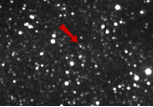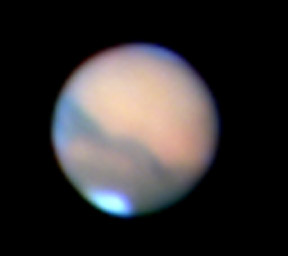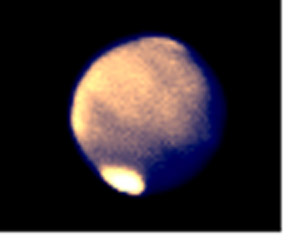
Planet Photos
The Footprint of Pluto

Pluto on 11-01-09
Pluto is presently passing about in the Milky Way. This presents a plethora of opportunities for observing occultations. It begins in March as Pluto rises at about 3 a.m. CST and ends in October when Pluto is first observable just after dark until it sets in the west at about 10 p.m.
At the urging of a friend I have elected to accumulate a large number of images of the region near Pluto with the idea of searching for satellites or ring systems by the occultation method. The plan, partly implemented in October 2009, is to operate the 8-inch SCT making hundreds of 30 second images each evening and with the 14-inch SCT making thousands of 0.5 second images.
The images will be reduced and examined by the fireside over time. A 100 arc second radius will be examined before Pluto's entrance, during its stay, and after its exit. Typically this is day1, day2, and day3.
In the end it may show nothing except an exercise in reducing occultation measurement to its absolute limit. Only an amateur can proceed to expend such time and effort with so little assurance of discovery.
Pluto Update: Progress to 4-11-10
The sky cleared for just a few days. We were able to operate for typically 3 hours on 4-8-10, 4-9-10, and 4-10-10. As planned we typically recorded 200 images per day at 30 seconds each on the SBIG ST-8 using the 8-inch SCT. We recorded typically 4000 images per day at 1 second each on the ANDOR LUCA using the 14-inch SCT. The two setups complement each other.
On these days Pluto was passing through its eastern extension so was nearly stopped in RA and had only a small rate of movement in DEC. The time frame for any occultation by the main body would have been of the order of one-half hour so the 30 second images were not trivial as one might have assumed for any other observing time. No analysis has been done to date.
This was an important test of operations. All worked well. During the next sessions we will consider some alternate scenarios. In particular, operating the 8-inch telescope at f:10 rather than f:6.3 and operating the 14-inch telescope at f:6.3 rather than at f:3.3 may be useful as the image of Pluto increases in speed in the sky.
Mars


Saturn
